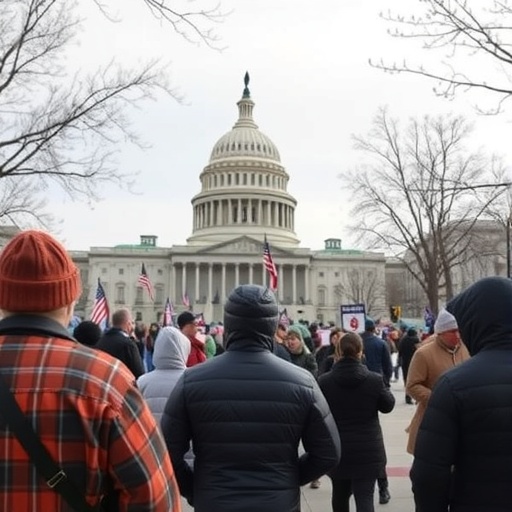US Government shutdown Enters Day 21: Senate’s 11th Failed Vote Leaves Federal Workers Desperate for Food Aid
In a stark display of political gridlock, the US Government shutdown has dragged into its 21st day, with the Senate failing for the eleventh consecutive time to pass a resolution to reopen federal operations. This impasse, one of the longest in American history, is inflicting profound hardship on hundreds of thousands of federal workers who are now relying on food banks and scrambling for side jobs just to put meals on the table. As the clock ticks past three weeks, the human cost of this US politics stalemate is becoming impossible to ignore, raising urgent questions about the nation’s fiscal priorities and bipartisan cooperation.
- Senate’s Repeated Deadlock Fuels National Frustration
- Federal Workers Turn to Food Banks as Paychecks Vanish
- Economic Fallout Hits Small Businesses and Communities Hard
- Voices from the Hill: Lawmakers Grapple with Shutdown’s Human Toll
- Path Forward: Potential Breakthroughs and Lingering Risks in US Politics
The shutdown, triggered by deep divisions over federal spending—particularly contentious issues like border security funding—has frozen paychecks for over 800,000 federal employees. Non-essential services have ground to a halt, from national parks to regulatory agencies, while essential workers like air traffic controllers and border agents continue laboring without compensation. Economists estimate the shutdown is costing the US economy up to $1.6 billion per week, but for the individuals caught in the crossfire, the toll is far more personal and immediate.
Senate’s Repeated Deadlock Fuels National Frustration
The Senate chamber, often a symbol of deliberative democracy, has become a theater of futility as the 11th vote to end the Government shutdown crumbled under partisan lines. On Tuesday evening, the measure fell short by a mere seven votes, with Democrats decrying the lack of protections for Dreamers and Republicans insisting on stringent border wall allocations. Senate Majority Leader Mitch McConnell (R-KY) expressed exasperation in a post-vote statement, saying, “We’ve seen enough division; it’s time for real negotiation rather than procedural theater.”
This marks the latest in a series of procedural votes that have tested the patience of lawmakers and the public alike. Historical data from the Congressional Research Service shows that the current shutdown surpasses the 1995-1996 impasse, which lasted 21 days, making it the second-longest in modern US history. Only the 2018-2019 shutdown, which stretched to 35 days, eclipses it. Behind the scenes, sources close to the negotiations reveal that hardline conservatives are holding firm, refusing to budge without concessions on immigration policy, while progressives demand comprehensive spending bills that address healthcare and infrastructure.
The procedural hurdles are compounded by Senate rules requiring 60 votes to overcome a filibuster, a threshold that has proven elusive amid polarized US politics. As one anonymous Senate aide told reporters, “Every vote feels like Groundhog Day—same arguments, same outcomes, and no end in sight.” Public approval ratings for Congress have plummeted to 18%, according to a recent Gallup poll, with 72% of Americans blaming both parties equally for the chaos.
Federal Workers Turn to Food Banks as Paychecks Vanish
For the roughly 800,000 federal workers affected by the government shutdown, the absence of pay is not an abstract policy debate—it’s a daily struggle for survival. In cities across the nation, from Washington D.C. to Denver, federal employees are queuing up at food pantries, a humiliating turn for those who staff the very agencies keeping the country running.
Take Maria Gonzalez, a 45-year-old IRS auditor from Fairfax, Virginia, who has worked for the government for 18 years. “I’ve never missed a mortgage payment, but now I’m choosing between groceries and gas,” she shared in an interview with local news outlet WTOP. Gonzalez, like many, has turned to food aid programs run by organizations such as Feeding America, which reported a 25% spike in demand from federal workers since the shutdown began. In the Washington area alone, Capital Area Food Bank distributed over 1.2 million pounds of food last week, with furloughed employees making up a significant portion of recipients.
Statistics paint a grim picture: The Partnership for Public Service estimates that 40% of affected federal workers are dipping into savings, while 15% are taking on gig economy jobs via platforms like Uber and DoorDash. A survey by the National Treasury Employees Union found that 60% of respondents worry about covering basic expenses, with childcare and medical bills topping the list of concerns. For essential workers who must report to duty without pay—such as TSA screeners and FDA inspectors—the strain is even greater, as they forgo overtime that could have cushioned the blow.
Regional impacts vary, but the ripple effects are widespread. In Alaska, where federal jobs dominate the economy, Coast Guard families are seeking emergency assistance from local charities. “We’re seeing Coasties who protect our shores now needing help to feed their own kids,” said Beth Kashatok, director of the Bering Sea Fishermen’s Union Food Bank. Nationally, the shutdown has led to a 10% increase in unemployment claims from federal contractors, exacerbating the squeeze on federal workers.
Economic Fallout Hits Small Businesses and Communities Hard
Beyond the immediate plight of federal workers, the prolonged government shutdown is sending shockwaves through the broader economy, particularly small businesses dependent on federal contracts and tourism. In national parks like Yosemite and the Grand Canyon, which have been partially closed, local vendors report losses exceeding $50 million since the shutdown started. The US Travel Association projects that the tourism sector could lose up to $3 billion if the impasse continues.
Small business owners are feeling the pinch acutely. In Quantico, Virginia, near a major Marine Corps base, restaurant owner Raj Patel has seen a 30% drop in lunchtime crowds as unpaid service members cut back on dining out. “These are folks who come in every day, but now they’re packing lunches to save every penny,” Patel told CNN. The National Federation of Independent Business warns that prolonged shutdowns could lead to 10,000 small business closures, with sectors like construction and defense contracting hit hardest due to halted projects.
On the macroeconomic front, the Federal Reserve has downgraded its growth forecast, citing the shutdown’s drag on GDP. Standard & Poor’s estimates a $18 billion hit to the economy over the shutdown’s duration so far, with potential for more if it extends into February. Stock markets have shown volatility, with the Dow Jones dipping 1.2% on the day of the Senate’s latest failed vote, as investors fret over delayed tax refunds and regulatory approvals.
Communities reliant on federal programs are also suffering. Head Start programs for low-income children have furloughed staff, affecting 1 million kids nationwide. Women’s health clinics funded by the government report staffing shortages, leading to delayed appointments. “This isn’t just about Washington; it’s about real people in real towns losing access to vital services,” said Rep. Nancy Pelosi (D-CA) in a floor speech, highlighting the shutdown’s far-reaching tendrils.
Voices from the Hill: Lawmakers Grapple with Shutdown’s Human Toll
As the Senate remains mired in deadlock, lawmakers from both sides of the aisle are beginning to acknowledge the human stories emerging from the government shutdown. Sen. Chuck Schumer (D-NY), the minority leader, took to the floor after the 11th failed vote, his voice cracking as he read letters from constituents. “One Coast Guard wife wrote that her family is relying on church donations for diapers. This is the face of our broken system,” Schumer said, urging Republicans to drop their demands for a border wall emergency declaration.
Even on the Republican side, cracks are appearing. Sen. Susan Collins (R-ME), a moderate, co-sponsored a bipartisan bill to provide back pay guarantees but lamented its failure. “We can’t let ideology trump compassion. Federal workers are patriots, not pawns in our games,” she stated in a press conference. House Speaker Paul Ryan (R-WI) echoed calls for compromise, noting in a Fox News interview that “the American people deserve better than this endless loop.”
Advocacy groups are amplifying these voices. The Coalition for Humane Immigrant Rights (CHIRLA) has rallied outside the Capitol, linking the shutdown to broader US politics failures on immigration reform. “This is what happens when we prioritize walls over people,” said executive director Angelica Salas. Meanwhile, labor unions like the American Federation of Government Employees (AFGE) have filed lawsuits challenging the constitutionality of unpaid essential work, arguing it violates labor laws.
Public sentiment is shifting too. A Monmouth University poll released Wednesday shows 55% of voters now view the shutdown as a “crisis,” up from 42% a week ago, with independents particularly incensed. Social media is ablaze with #EndTheShutdown hashtags, featuring viral videos of furloughed workers at food aid lines and memes lampooning congressional inaction.
Path Forward: Potential Breakthroughs and Lingering Risks in US Politics
Looking ahead, the road out of this government shutdown remains fraught with uncertainty, but glimmers of hope persist amid the despair. House Democrats, controlling the lower chamber, passed a clean funding bill last week, only for it to stall in the Senate. Negotiators from both parties are slated to meet privately this Friday, with sources indicating possible concessions on disaster relief funding to sway holdouts.
President Donald Trump, who has tied the shutdown to his border wall ambitions, hinted at flexibility in a Tuesday tweet: “Great progress being made—stay tuned!” However, White House officials caution that any deal must include wall funding, potentially prolonging the standoff. Bipartisan talks could focus on a short-term continuing resolution to reopen the government while deferring contentious issues to a later debt ceiling debate.
The risks of escalation are real. If the shutdown surpasses 30 days, it could trigger widespread layoffs among contractors and further erode trust in institutions. Economists warn of a potential recessionary spiral if consumer confidence wanes. For federal workers, back pay is promised once resolved, but the psychological scars—stress, anxiety, and eroded morale—may linger. Initiatives like expanded food aid through USDA waivers are helping, but experts call for systemic reforms, such as automatic shutdown pay or filibuster changes, to prevent future crises.
In the end, this episode underscores the fragility of US politics in an era of deep division. As families ration meals and lawmakers haggle, the nation watches, hoping for a resolution that restores not just paychecks, but faith in governance. With midterm elections looming, the political calculus may finally tip toward compromise, but for now, the shutdown’s shadow looms large over America’s future.









